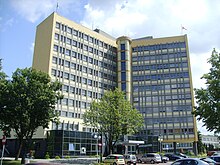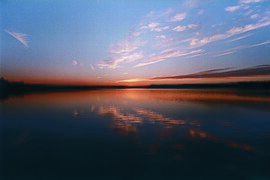Tychy
Tychy | ||
|---|---|---|
 Mary Magdalene Church | ||
|
Car plates ST | | |
| Website | https://umtychy.pl/ | |

Tychy (Polish pronunciation: [ˈtɨxɨ] ⓘ; German: Tichau; Silesian: Tychy) is a city in Silesia in southern Poland, approximately 20 kilometres (12 mi) south of Katowice. Situated on the southern edge of the Upper Silesian industrial district, the city borders Katowice to the north, Mikołów to the west, Bieruń to the east and Kobiór to the south. The Gostynia river, a tributary of the Vistula, flows through Tychy.
| Year | Pop. | ±% |
|---|---|---|
| 1960 | 49,914 | — |
| 1970 | 71,500 | +43.2% |
| 1980 | 166,573 | +133.0% |
| 1990 | 191,723 | +15.1% |
| 2000 | 133,463 | −30.4% |
| 2010 | 129,386 | −3.1% |
| 2020 | 126,871 | −1.9% |
| source [2] | ||
Since 1999 Tychy has been located within the Silesian Voivodeship, a province consisting of 71 regional towns and cities. Tychy is also one of the founding cities of the Metropolitan Association of Upper Silesia, a pan-Silesian economic and political union formed with the eventual aim of bringing the most populous Silesian areas under a single administrative body.
Tychy is well known for its brewing industry and the Tyskie brand of beer, which dates back to the 17th century.[3] Since 1950, Tychy has grown rapidly, mainly as a result of post-war socialist planning policies enacted to disperse the population of industrial Upper Silesia.[4][5]
History
Etymology
The moniker Tychy is derived from the Polish word cichy, meaning "quiet" or "still".[6] Although appropriate for most of Tychy's history, the name is now somewhat ironic considering the growth of the city from 1950 onwards.
Origins and development
Originally established as a small agricultural settlement on the medieval trade route between Oświęcim and Mikołów, Tychy was first documented in 1467.[7] In 1629 the first trace of serious economic activity was recorded in the shape of the Książęcy Brewery, which is now one of the largest breweries in Poland.[8]
From 1526 onwards the area on which Tychy is built was part of the Austrian Habsburg monarchy. Then in 1742 Prussia annexed the land after winning the First Silesian War against the Austrian Hasburg monarchy. In 1871 the territory became part of the German Empire until in 1918, for a short period between 1918 and 1921 Tychy was just inside the border of the newly formed Weimar Republic and still a part of the German Province of Silesia. On 16–17 August 1919 the Battle of Paprocany (present-day district of Tychy) was fought as one of the first battles of the Silesian Uprisings (1919–1921). After the uprisings Tychy was reintegrated with the re-established Polish state. Additionally, due to the Polish majority in 1921 in Tychy and the few Germans, 84% of the inhabitants voted for joining Poland during the plebiscite.[9]
Shortly after its cession to Poland, Tychy began to develop into a small urban settlement, acquiring a hospital, a fire station, a post office, a school, a swimming pool, a bowling hall and a number of shops and restaurants. In 1922 it was visited by leader of interwar Poland, Józef Piłsudski.[10] Its population also grew between World War I and World War II, reaching a population of 11,000 at its highest point during this time.[7]
World War II

Along with the rest of industrial Upper Silesia Tychy was occupied by Nazi Germany forces after the invasion of Poland and annexed into the Third Reich,[11] while many of its inhabitants who were not expelled or exterminated were forced to change their nationality to German in order to comply with the racist policies of Nazi Germany.[12] Mass arrests and executions of Polish activists and former Polish insurgents of 1919–1921 were carried out in the first days of the occupation in September 1939.[13] As early as September 3, 1939, the Germans murdered several Polish residents of the city, of whom 13 were later identified, the youngest was 16 years old.[14] The Germans also carried out manhunts of Polish insurgents who were hiding in the forest between Tychy and Mikołów,[15] and established and operated a Polenlager forced labor camp for Poles in the city,[16] and the E701 labor subcamp of the Stalag VIII-B/344 prisoner-of-war camp in the present-day Czułów district.[17] The last public execution was carried out on September 22, 1944, when five members of the underground Polish resistance movement were killed.[18] Tychy received minimal damage during the invasion because most of the nearby fighting took place in the Mikołów-Wyry area.[7] In the final stages of the war, in 1945, a German-conducted death march of thousands of prisoners of the Auschwitz concentration camp and its subcamps passed through the city towards Gliwice.[19]
Tychy was liberated on January 28, 1945.[10]
New Tychy
The "New City" was designated by the Polish government in 1950 and deliberately located near to
In the administrative reforms which came into effect in 1999, Tychy was made a city with the status of a powiat (city county). Between 1999 and 2002, it was also the administrative seat of (but not part of) an entity called Tychy County (powiat tyski), which is now known as the Bieruń-Lędziny County.

The Tyskie Brewing Museum was founded in 2004, and the Municipal Museum in 2005.[10]
Districts
Tychy is divided into 17 districts (dzielnicas):
- Cielmice (south)
- Czułów (north)
- Glinka, Tychy (west)
- Jaroszowice (north-east)
- Mąkołowiec (north-west)
- Paprocany (south)
- Radziejówka (north-west)
- Śródmieście (city centre)
- Stare Tychy (centre)
- Suble
- Urbanowice, Tychy (east)
- Wartogłowiec (north)
- Wilkowyje (north-west)
- Wygorzele (north)
- Zawiść (north-east)
- Zwierzyniec (north)
- Żwaków (west)
Industry
The global car manufacturer
Also located in Tychy is a powertrain factory producing automobile engines for
The Tyskie beer is produced in Tychy, by Kompania Piwowarska, a subsidiary of the multinational brewing company Asahi Breweries. It is reportedly one of the best selling brands of beer in Poland, with around 18% share of the Polish market as of 2009[update].[24]
Transport

In Tychy operates one of three remaining trolleybus systems in Poland.
Roads
Culture

street Żwakowska 8/66, 43-100 Tychy
tourist region: Upper Silesian Agglomeration.
Art galleries and museums
Sports

Tychy is home to two major sporting teams, both named GKS Tychy. GKS stands for Górniczy Klub Sportowy, (English: Miner's Sporting Club), which is a common prefix for Polish sports teams situated near mines or in mining regions.
Ice hockey

The
Several players from the club have gone on to play in the American and Canadian NHL. These include Mariusz Czerkawski and Krzysztof Oliwa.
Football
The
A few notable footballers were either born in Tychy or spent some of their career at the club, the most famous being
Tychy hosted several matches of the 2019 FIFA U-20 World Cup.
Other sporting teams
Tychy is also home to several other sports teams, including basketball team Big Star Tychy, futsal team GKS Jachym Tychy and floorball team TKKF Pionier Tychy.
Notable people
Tychy has been the birthplace and home of notable people, both past and present. German sculptor
Soldier Roman Polko (born 1962) is one son of Tychy whose achievements hold national importance today. His distinguished career has led him to the post of acting chief in Poland's Bureau of National Security.


- August Kiss (1802–1865), German sculptor
- Józef Krupiński (1930–1998), poet and lyricist
- Roman Ogaza (1952–2006), footballer
- Lucyna Langer (born 1956), athlete
- Ryszard Riedel (1956–1994), musician, lead singer of blues-rock band Dżem
- Ireneusz Krosny (born 1968), pantomime comedian
- Adam Juretzko (born 1971), German wrestler[26]
- Mariusz Czerkawski (born 1972), ice-hockey player
- Krzysztof Oliwa (born 1973), ice-hockey player
- Piotr Tomasz Nowakowski (born 1974), Polish researcher, university faculty and writer
- Bartosz Karwan (born 1976), footballer
- Piotr Kupicha (born 1979), musician, lead singer of pop-rock band Feel
- Adam Bielecki(born 1983), Polish alpine and high-altitude climber
- Łukasz Sinkiewicz(born 1985), Polish-German footballer
- Michał Brzozowski (born 1988), footballer
- Dawid Tomala (born 1989), race walker, Olympic Champion
- Jakub Świerczok (born 1992), footballer
- Arkadiusz Milik (born 1994), footballer
- Szymon Żurkowski (born 1997), footballer
- Jakub Kiwior (born 2000), footballer
Twin towns – sister cities
 Cassino, Italy
Cassino, Italy Marzahn-Hellersdorf (Berlin), Germany
Marzahn-Hellersdorf (Berlin), Germany Oberhausen, Germany
Oberhausen, Germany
Gallery

-
Old railway building at the old brewery
-
Osiedle A in Tychy, built in the 1950s
-
Cooperative bank in the city centre
-
Stefan Rowecki monument
-
Hotel Piramida
-
Park Łabędzi
-
Paprocany Lake
-
Paprocany Lake
See also
References
- ^ "Local Data Bank". Statistics Poland. Retrieved 7 August 2022. Data for territorial unit 2477000.
- ^ "Tychy (śląskie) » mapy, nieruchomości, GUS, noclegi, szkoły, regon, atrakcje, kody pocztowe, wypadki drogowe, bezrobocie, wynagrodzenie, zarobki, tabele, edukacja, demografia".
- ^ "Tychy" Archived 2005-05-14 at the Wayback Machine, Microsoft Encarta Online Encyclopedia 2009, Retrieved 2006-07-02
- ^ Duvall, C and Winstan Bond. (2003). Suburbanising the Masses: Public Transport and Urban Development in Historical Perspective. p. 114. Ashgate Publishing
- ^ Lipk-Bierwiaczonek, M. "Całkiem nowe miasto socjalistyczne" Archived 2009-03-28 at the Wayback Machine, Gazeta.pl Katowice, (in Polish), Retrieved 2006-07-02
- ^ Room, A. (2005). Placenames of the World. Second Edition p. 386. McFarland and Company
- ^ a b c Umtychy.pl[permanent dead link], "History of Tychy", Retrieved 2006-07-02
- ^ Umtychy.pl[permanent dead link], "Monuments", Retrieved 2006-07-02
- Encyclopædia Britannica Online, Retrieved 2006-07-02
- ^ a b c d e f g h "Historia Tychów". eTychy.org (in Polish). Retrieved 14 March 2020.
- ^ ^ Cienciala, Anna M. (2004). "The Coming of the War and Eastern Europe in World War II" Archived 2012-08-01 at the Wayback Machine University of Kansas. Retrieved on 2009-07-03
- ^ Kamusella, T. (1999) The Dynamics of the Policies of Ethnic Cleansing in Silesia in the Nineteenth and Twentieth Centuries Archived 2017-02-24 at the Wayback Machine p. 381 Open Society Institute. Retrieved 2009-07-03
- ^ Wardzyńska, Maria (2009). Był rok 1939. Operacja niemieckiej policji bezpieczeństwa w Polsce. Intelligenzaktion (in Polish). Warszawa: IPN. p. 131.
- ^ Wardzyńska, p. 133
- ^ Wardzyńska, p. 119
- ^ "Polenlager Tichau". Bundesarchiv.de (in German). Retrieved 3 June 2021.
- ^ "Working Parties". Lamsdorf: Stalag VIIIB 344 Prisoner of War Camp 1940 - 1945. Archived from the original on 20 January 2021. Retrieved 14 March 2020.
- ^ "Pomnik ofiar hitlerowców 22.09.1944". UMTychy.pl (in Polish). Retrieved 14 March 2020.
- ^ "The Death Marches". Sub Camps of Auschwitz. Retrieved 27 June 2021.
- ^ Rozporządzenie Prezesa Rady Ministrów z dnia 8 listopada 1950 r. w sprawie nadania ustroju miejskiego niektórym gminom w województwach: katowickim i warszawskim, gromadzie Hajnówka w województwie białostockim oraz zniesienia i zmiany granic niektórych miast i gmin w województwach katowickim i białostockim., Dz. U. z 1950 r. Nr 51, poz. 472
- ^ Schwartz, Nelson D. (2009-07-14). "To Shrink a U.S. Car, Chrysler Goes to Poland". The New York Times. Retrieved 2009-07-14.
- ^ "Bardzo smutna data w historii "polskiej" motoryzacji". Motoryzacja. 2012-12-21. Retrieved 2013-07-13.
- ^ "GM Purchases Remaining Shares in Tychy Plant". media.opel.com (press release). 2013-04-22. Retrieved 12 February 2014.
- ^ "Kompania Piwowarska has managed to increase its market share significantly in spite of the industry's dip in sales". SABMiller. 1 March 2010. Archived from the original on 16 December 2012.
- ^ "Muzeum Miniaturowej Sztuki Profesjonalnej Henryk Jan Dominiak in Tychy". muzeumminiaturowejsztukiprofesjonalnejhenrykjandominiak.eu. 17 December 2015. Archived from the original on 19 April 2022. Retrieved 11 April 2022.
- ^ de:Adam Juretzko
- ^ "Miasta partnerskie". umtychy.pl (in Polish). Tychy. Retrieved 2020-03-11.
External links
![]() Media related to Tychy at Wikimedia Commons
Media related to Tychy at Wikimedia Commons
- Makropix.com Archived 2013-02-23 at the Wayback Machine, 360° interactive view of a square in Old Tychy









